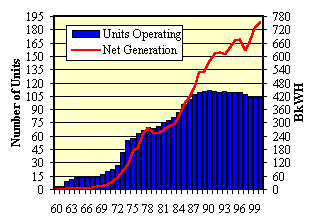 Much attention has been given recently to the potential for a renaissance in nuclear power, especially in the United States, given the energy crisis in California and rise in natural gas prices. This development likely contributed to an increase in stock prices for nuclear fuel companies, including Cameco and USEC, as the perception that nuclear is becoming a "growth" industry took hold. After these stocks initially increased, they retreated, partly because of the realization that new nuclear plants will not be built immediately, and even if they were, there is a lag time before the demand associated with these reactors emerges.
Much attention has been given recently to the potential for a renaissance in nuclear power, especially in the United States, given the energy crisis in California and rise in natural gas prices. This development likely contributed to an increase in stock prices for nuclear fuel companies, including Cameco and USEC, as the perception that nuclear is becoming a "growth" industry took hold. After these stocks initially increased, they retreated, partly because of the realization that new nuclear plants will not be built immediately, and even if they were, there is a lag time before the demand associated with these reactors emerges.
What might not be clear to some observers, including those in the investment community, is the tremendous growth in U.S. uranium consumption that has taken place without the construction of new reactors. This demand growth, which has had sort of a "stealthy" character but is every bit as real as demand associated with new reactors, has been nothing short of remarkable and continues today. As no new reactors have been built in the U.S., this growth has been a product of increased operating efficiency of reactors, including power uprates of reactors and higher tails assays.
To appreciate how dramatic the growth in U.S. requirements has been, it is instructive to take an historical perspective. The first chart displays uranium requirements forecasts made by the EIA in 1989. These forecasts were predicated on different assumptions for installed nuclear capacity in the United States: no new orders, a lower reference case calling for minor additions to capacity through 2010, and an upper reference case calling for an additional 40 GWe of capacity by 2010. As shown in the chart, EIA projected that U.S. requirements would stay below 40 million pounds in all three scenarios until the 2001-2005 period, when the upper reference case exceeded 40 million pounds. It was not until the 2006-2010 period that it was projected that the 50 million level would be exceeded, again by the upper reference (high nuclear growth) case.
Actual U.S. requirements have turned out to be quite different than those projected in 1989. The second chart depicts fuel loaded into U.S. reactors over the past ten years, based on data collected by EIA. While loading patterns are somewhat irregular, fitting a trend line to these data shows that U.S. requirements grew from a trend-adjusted 39 million pounds in 1991 to about 52 million pounds in 2000, an increase of 13 million pounds or 33%, without any new reactor growth.
|
This "disconnect" between installed nuclear capacity and requirements growth was made possible by the tremendous increase in the efficiency of existing U.S. nuclear reactors. The third chart shows how electricity generation from U.S. nuclear reactors continued to grow strongly despite the fact that the number of reactors leveled off and actually declined somewhat.
A key question is the extent to which this requirement gain can continue without the construction of new reactors. While a large portion of the efficiency gains has been realized (the average U.S. capacity factor has now topped 90%), further gains are possible, if not likely. In addition, the NRC expects 46 reactors to submit applications for power uprates by 2005. Also, there has recently been talk of restarting idled reactors (Browns Ferry 1) and finishing partially completed reactors (Bellefonte 1 & 2 and WNP 1). Finally, a move to higher tails assays could create additional uranium requirements (although this would come at the expense of enrichment requirements). Thus, there are a number of factors that can contribute to continued requirements growth in the U.S., even before a new reactor is ordered.
This subject is examined in greater detail in our current Uranium Market Outlook report.
1989 EIA U.S. Uranium Requirements Forecast

Net Nuclear Generations vs.
Uranium Loaded into U.S. Reactors, 1991-2000

Number of Units Operating, 1960-2000

|